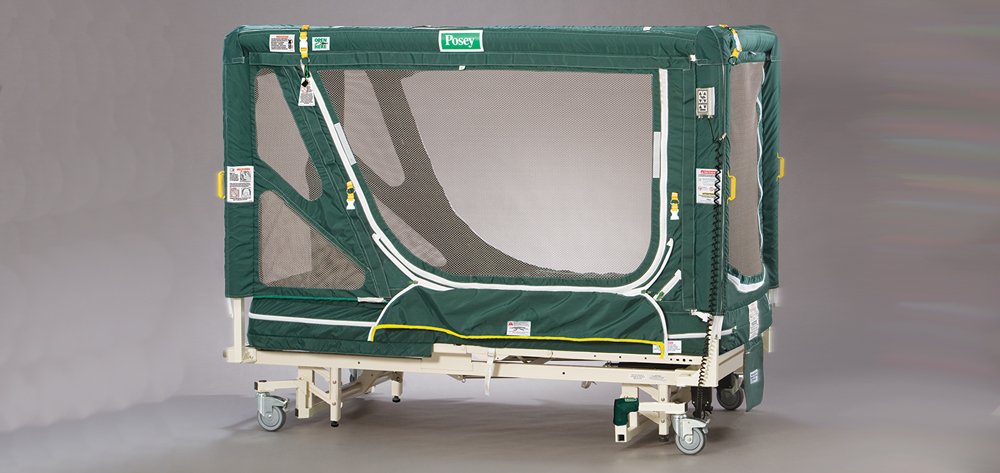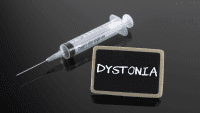An enclosure bed can be used as part of a patient’s plan of care to prevent falls and provide a safer environment. This specialty bed has a mesh tent connected to a frame placed over a standard medical-surgical bed. Although it’s considered a restraint because it limits the patient’s ability to get out of bed, an enclosure bed is less restrictive than other types of restraints. It can be used as an alternative when a vest restraint would cause more agitation and wrist restraints aren’t appropriate.
My 750-bed academic medical center became interested in the enclosure bed in 2007 as a way to decrease patient falls and patient-sitter costs. We’ve seen the enclosure bed have a calming effect on patients and give them more freedom than wrist and ankle restraints. Our hospital rents the bed; for a 24-hour period, the daily rental expense is much lower than the cost of a patient sitter. (See A look at the enclosure bed.)
Indications
Use of the enclosure bed hinges on the patient’s behavior, so a patient-specific comprehensive assessment must be done. The bed may be indicated for patients who are at high risk for falls; are confused, impulsive, restless, or agitated; are unable to ask for assistance or respond to redirection; or who climb out of bed when it’s unsafe to do so.
Other patients who might benefit from an enclosure bed include those with Alzheimer’s disease or other types of dementia, traumatic brain injury, seizure disorder, Huntington’s disease, or developmental delays. The bed also may be indicated for patients recovering from stroke, as well as for patients with delirium associated with alcohol withdrawal who have completed treatment for acute withdrawal.
Inclusion criteria
To be considered for the enclosure bed, the patient must be at high risk for falling and must demonstrate one or more of the following:
- impulsiveness
- agitation
- inability or unwillingness to ask for assistance or respond to redirection
- unsteady gait
- wandering behavior.
A history of falling alone isn’t enough to warrant use of the enclosure bed or other restraints.
Exclusion criteria
Patients shouldn’t be placed in an enclosure bed if they are violent, combative, self-destructive, suicidal, or claustrophobic. Although the bed has small holes for one or two I.V. lines and an indwelling urinary catheter, patients with multiple lines generally are excluded. If the patient becomes increasingly agitated, terrified, or distraught after being placed in the bed, clinicians must reassess the situation and try a different intervention.
Evaluation period
Before our hospital decided to add the enclosure bed to our approved specialty rental inventory, staff nurses and other providers conducted an evaluation to identify patient risk behaviors that could be managed in this bed. The hospital conducted a 6-month trial of the enclosure bed, during which staff used the bed and completed an evaluation tool. The tool asked specific questions about staff comfort level with the bed, ease of use, family response to the bed, and whether the bed met the patient’s needs.
Education and implementation
Based on staff feedback and positive patient outcomes during the evaluation, the enclosure bed was added to potential interventions to prevent falls and to provide a safer environment for patients. Our facility has developed processes to request or order the bed, monitor the patient while in the bed, and discontinue the bed.
The enclosure bed was introduced as a type of restraint to providers who have the authority to order restraints. Staff nurses received education on indications for the bed, how to operate it, and documentation requirements. Nursing staff at the unit level worked with provider teams to implement the enclosure bed.
Education consisted of reviewing the procedural checklist, watching an instructional video and completing a self-learning module on restraint use. During the demonstration on how to zip the panels and use the locks on the zippers, nurses had the chance to get into the bed to see what it’s like.
Required processes
Before an enclosure bed is requested, nursing staff must review with the provider team the behavior that puts the patient at risk for falls and injury, as well as for impulsive behavior that harm the patient or staff. One example is an impulsive patient with early-onset dementia who is hitting and kicking at staff.
As with all restraints, an enclosure bed requires a provider restraint order that must be renewed every 24 hours. Before a patient is placed in the bed, staff try less restrictive options, such as distraction, bed and chair alarms, reducing stimuli, and moving the patient to a room closer to the nursing station. Once the decision to use an enclosure bed is made, clinicians must educate the family about the bed, its function, the reason for using it, how the panels are zipped and unzipped, and how the bed contributes to a cocoon-like environment. If family members aren’t available in the hospital, the charge nurse contacts a family member by phone to explain the change in the patient’s care.
Using a restraint flowsheet, nursing staff document the patient’s response to the enclosure bed and the frequency with which they met the patient’s care needs during bed use.
When the patient’s behavior improves, the enclosure bed is discontinued. The specialty bed coordinator is notified and the vendor picks up the bed.
Placing the patient in the bed
Before using the bed, inspect it for proper assembly. Then unzip the bed and adjust the head of the bed. Once the patient has been placed in the bed, sit in a chair next to the bed for a few minutes with the sides unzipped to help him or her get acclimated. Adjust the head of the bed so the patient can sit in it comfortably. Then zip the sides and see how the patient reacts to the enclosure. If the patient will be left alone, place a call button within reach.
The patient’s activity schedule should include getting him or her out of the bed multiple times a day. Staff should assist the patient to ambulate at least three times daily. The patient should sit in a bedside chair for all meals, if able to tolerate ambulation and activity. According to the Centers for Medicare & Medicaid Services’ Interpretive Guideline §482.13(e) (6), “a temporary, directly supervised release…for the purposes of caring for a patient’s needs
(e.g. toileting, feeding, or range-of-motion exercises) is not considered a discontinuation of the restraint. As long as the patient remains under direct staff supervision, the restraint is not considered to be discontinued because the staff member is present and is serving the same purpose as the restraint.”
Outcomes
In our hospital, the enclosure bed was incorporated quickly into the safety plan for med-surg patients. The adult med-surg nursing staff has used the bed with more than 200 patients. On average, patients stay in the bed about 6 days; no patient falls or injuries have occurred. In some facilities, using the bed decreases overall sitter expenses. Our experience has shown a slight reduction in sitter hours when the bed is used.
Based on our positive experiences and patient outcomes, we will continue to use the enclosure bed as an option for fall prevention and patient safety.
Several patients have been discharged from our hospital with a plan of care that included an enclosure bed. In the home, the bed can be used for patients with agitation secondary to dementia or for pediatric patients with significant chronic neurologic or behavioral problems. The experience the families gained with the enclosure bed in the hospital helped provide a safe discharge plan for several patients.
Involving staff with an initial trial of the bed, identifying appropriate patient criteria, and educating staff, patients, and families about the bed’s benefits have contributed to successful implementation of this specialty bed.
References
Centers for Medicare & Medicaid. Interpretive Guidelines for Hospitals. State Operations Manual Appendix A – Survey Protocol, Regulations and Interpretive Guidelines for Hospitals. Conditions of Participation for Hospitals, 42 CFR Appendix A.§482.13(e)(6). October 2008. www.cms.gov/Regulations-and-Guidance/Guidance/Transmittals/downloads/ R37SOMA.pdf. Accessed November 9, 2014.
Jennifer L. Harris is a senior advanced practice nurse at the University of Rochester Medical Center-Strong Memorial Hospital in Rochester, New York.



















10 Comments.
Enclosure bed to confining was in one 247 for week had to be kept in diapers couldn’t walk when I got out
I felt this was used inappropriately for my father. My dad has no ability to use a call bell and yet was placed in a net enclosure bed. I was not consented for this as his healthcare power of attorney and he was unable to consent due to dementia. He was not violent. No lesser restraints were tried first such a quiet room, or room closer to the nurses’ station. He did not have a Ava camera to monitor him without restrains and did not have s bed that lowered nor fall mats. He went into rehab reliably asking to use a urinal and came out with severe depression and complete incontinence.
Can I rent a soma bed for use in assisted living facility? How much to rent?
Can a soma bed be purchased for home use? Price and does medicare or VA help for ,this type bed?
my mom is blind and hulsanates, she climbs out of bed at night , please let me know how i can get one for her
Can we purchase one of these ?
How would I get a soma bed for my sister in law,she is in one at the hospital now,she has demincha frontoteemporal the aggressive type,and we are bringing her home in a few days,and we can’t locate a soma bed for her,we will be using waist restraints on her to try to keep her in bed.no other facilities will take her.
It is a very nice website. Thanks for giving full information about Hospital Beds.
How much is this??? I really need one… Is really expensive???? The Medicare paid for that????? My father has Dementia & Alzheimer…
At night is no easy… Somebody cant help me about the price??? Thanks!!
Is this bed not considered “seclusion” by CMS definition “involuntary confinement of a patient alone in a room or area from which the patient is physically prevented from leaving.” This would require Q15 minute assessment by nursing?
Thanks